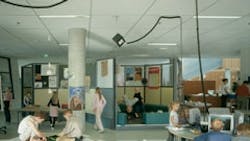A superior education is the key to prosperity, and the ability of a nation and its people to compete. The Federal Reserve chairman, Ben S. Bernanke, said recently that disparities in education and training were “likely the single greatest source of the long-term increase in inequality.”
Today's educators require flexible spaces that can accommodate multiple functions and future demands. They need spaces that enhance modern teaching methods and a student's personal development. Although architecture by itself cannot provide a good education, the environment it creates has an important effect on a student's well-being and ability to learn. Educators want environments where students can explore and experience their creative capabilities. Their social development may accelerate in school facilities that bring students of different ages together, particularly in open teaching areas.
Communities often need to share school facilities. Changing social patterns require additional services at schools. Constrained municipal budgets lead to more multi-use buildings that serve educational and community needs. Designing schools is an increasingly collaborative effort that includes teachers, students, education consultants and parents. In response to these changing policies and requirements, many architects are creating schools that look, feel and function differently.
Learning from others
Few municipalities have worked on these issues with more determination than the City of Zurich, Switzerland, a financial center and home to many of the world's largest companies. For the past five years, an international survey found that Zurich is “the city with the highest quality of living in the world.” An important contributor to that perception is the quality of the city's education system.
Ninety-three percent of Zurich's school children attend public schools. There are no tuition fees for its residents, from kindergarten through state and federal universities. There are 4,000 teachers (who earn an average of $100,000 per year) for 25,000 students; 40 percent of these students are foreign nationals from more than 165 countries, speaking more than 60 different languages. The city spends an average of $14,500 a year per student.
Zurich officials came to New York City earlier this year for a symposium sponsored by the American Institute of Architects (AIA) New York Chapter's Center for Architecture. It was part of an exhibition, “School Buildings: The State of Affairs — A New Architecture for a New Education,” first shown in Zurich in 2004 that highlighted the designs of 31 European schools.
Tony Vinzenz, the director of Zurich's public school system, explained during the symposium some of the goals and policies of the system:
-
The city of Zurich shall be maintained and extended as a center of products and services, and its quality of life ensured and advanced. To that extent, a child is to be guided into the community. Elementary school makes an important contribution to the integration of all children into society by supporting the cooperative living, working and learning of all children.
-
In public schools, every student shall be made successful. It is essential to tap into the full potential of each child. Always give every child a chance at school. Cultivate a climate in which all children find a place and feel comfortable.
-
School helps students understand the world and learn to live in society; pupils are part of a class, part of a school and part of a community. Every child has a perspective.
-
Schools help shape the digital world. The aim is to help students develop the ability to find the desired facts in a sea of information, to control media consumption sensibly and appropriately, and to distinguish reality from fiction. Competence in speaking and writing is a prerequisite for all people, but schools must adjust to the fact that students are strongly Internet-oriented.
The goals and experiences of Zurich schools require spaces that are large and flexible. One school under construction there will provide nearly 2,000 square feet of instructional space for an average class of 22 students.
Mark Ziegler, head of Zurich's school maintenance department, says the size of classrooms has more than doubled since 1940, while class size has declined by 21 percent. A recently renovated school built in 1864 for 60 students per classroom now has 24 students for the same space.
Manuela Keller-Schneider, a teacher at Zurich's University of Teacher Education, says her own space requirements are based on what she calls “the psychology of learning as basis for the design of the learning environment.” Cognitive and motivation psychology research, she says, has shown that learning through knowledge construction has a lasting impact. Teaching knowledge without its context is receding. The change from teacher-centered to student-oriented modes of instruction requires new spatial concepts for schools, as does the resulting replacement of the traditional classroom identity with other socially cohesive forms.
Peter Ess, director of Zurich's Building Department, says that innovative design quality can be sustained only through architectural competition. Design competitions are being used for all of Zurich's public building projects; for school buildings, the juries are made up of architects, educators and parent representatives. Competitions are sanctioned by the Swiss equivalent of the AIA, following their guidelines and procedures.
The city also has started to include teachers, parents and students in post-occupancy evaluations. The newest development is to include this group in the final design development as well. There is a reason that the official name of Zurich's school system is “The People's School” rather than “public school.” Quality of construction is of equal concern, because maintenance over the lifespan of a school may consume five times the initial cost, says Ziegler. Zurich's current total construction cost for school buildings is around $400 per square foot.
Umberto Dindo, AIA, is chairman, AIA's New York Chapter Committee on Architecture.
